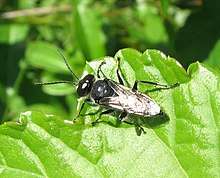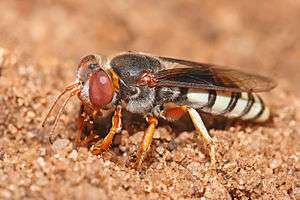Crabronidae
The Crabronidae are a large paraphyletic group (nominally a family) of wasps, including nearly all of the species formerly comprising the now-defunct superfamily Sphecoidea. It collectively includes well over 200 genera, containing well over 9000 species. Crabronids were originally a part of Sphecidae, but the latter name is now restricted to a separate family based on what was once the subfamily Sphecinae. As this change is very recent, the subfamilies of Crabronidae likely will each eventually be treated as families in their own right, as they have been treated as such by many authorities in the past (as in the catalog linked below).
| Crabronidae | |
|---|---|
 | |
| Tachysphex sp. | |
| Scientific classification | |
| Kingdom: | Animalia |
| Phylum: | Arthropoda |
| Class: | Insecta |
| Order: | Hymenoptera |
| Superfamily: | Apoidea |
| Family: | Crabronidae Latreille, 1802 |
| Subfamilies | |
|
Astatinae | |



Phylogeny
This phylogenetic tree is based on Sann et al., 2018, which used phylogenomics to demonstrate that both the bees (Anthophila) and the Sphecidae arose from within the former Crabronidae, which is therefore paraphyletic, and which they suggested should be split into several families; the former family Heterogynaidae nests within the Bembicidae, as here defined.[1] These findings differ in several details from studies published by two other sets of authors in 2017, though all three studies demonstrate a paraphyletic "Crabronidae."[2][3] Only three of these lineages were not included within Crabronidae in the past: Ampulicidae, Sphecidae, and Anthophila.
| Apoidea |
| ||||||||||||||||||||||||||||||||||||||||||||||||||||||||||||||||||
Subgroups
- Subfamily Astatinae
- Astata, etc.
- Subfamily Bembicinae
- Tribe Alyssontini
- Tribe Bembicini
- Tribe Gorytini
- Tribe Heliocausini
- Tribe Nyssonini
- Tribe Stizini
- Subfamily Crabroninae (incl. Eremiaspheciinae and Dinetinae)
- Subfamily Mellininae
- Mellinus
- Xenosphex
- Subfamily Pemphredoninae
- Microstigmus
- Lithium
- Pemphredon, etc.
- Subfamily Philanthinae
- Cerceris
- Philanthus, etc.
Life cycle
 Trypoxylon collinum larva
Trypoxylon collinum larva Trypoxylon collinum pupa
Trypoxylon collinum pupa Trypoxylon collinum adult
Trypoxylon collinum adult
See also
References
- Sann, Manuela; Niehuis, Oliver; Peters, Ralph S.; Mayer, Christoph; Kozlov, Alexey; Podsiadlowski, Lars; Bank, Sarah; Meusemann, Karen; Misof, Bernhard; Bleidorn, Christoph; Ohl, Michael (2018). "Phylogenomic analysis of Apoidea sheds new light on the sister group of bees". BMC Evolutionary Biology. 18 (1): 71. doi:10.1186/s12862-018-1155-8. PMC 5960199. PMID 29776336.
- Branstetter, Michael G.; Danforth, Bryan N.; Pitts, James P.; Faircloth, Brant C.; Ward, Philip S.; Buffington, Matthew L.; Gates, Michael W.; Kula, Robert R.; Brady, Seán G. (2017). "Phylogenomic Insights into the Evolution of Stinging Wasps and the Origins of Ants and Bees". Current Biology. 27 (7): 1019–1025. doi:10.1016/j.cub.2017.03.027. PMID 28376325.
- Peters, Ralph S.; Krogmann, Lars; Mayer, Christoph; Donath, Alexander; Gunkel, Simon; Meusemann, Karen; Kozlov, Alexey; Podsiadlowski, Lars; Petersen, Malte (2017). "Evolutionary History of the Hymenoptera". Current Biology. 27 (7): 1013–1018. doi:10.1016/j.cub.2017.01.027. PMID 28343967.
External links
| Wikimedia Commons has media related to Crabronidae. |
- Image Gallery from Gembloux
- Larra spp., mole cricket hunters on the UF / IFAS Featured Creatures Web site
